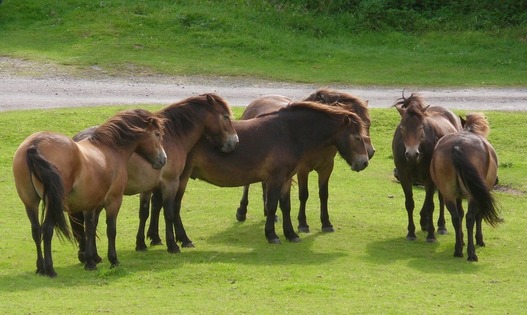
Are You & Your Horse Ready For Bitting Advice? The Steps You Need To Consider First
Equestrian Advice & Guides All Disciplines
Build your business profile for FREE and expose your services to thousands of potential clients!
Create my profile now!
The Exmoor pony is one of the nine native breeds of pony to be found throughout the British Isles. The pony originates from the moor in the south west from which it takes its name. The Exmoor for this reason is often seen as something of a pair with the other southwestern native breed, the Dartmoor pony. Although, both breeds are very different to one another.
Work done by the veterinary school in Edinburgh on its antecedents would indicate that the Exmoor pony is derived from the ancient British Wild Horse and it is generally deemed to be the oldest of the nine native breeds of pony. The Exmoor has a particular jaw formation for instance with a seventh molar tooth, this is not found in any other breed. The Exmoor pony is very easy to identify as the coat colour is uniformly bay, brown or sometimes dun, with absolutely no white markings. And the pony has what is called a mealy muzzle which is pale colouring around the muzzle and also around the eyes and lighter hair on the inside of the flanks, thighs and on the underside of the body. The Exmoor’s eyes are referred to as “toad eyes”, this rather unpleasant description refers to their hooded appearance which is to protect them against the harsh weather conditions to be found on the moor.
The Exmoor Pony Society was formed in 1921 to preserve and maintain the breed, a move which was also seen as very closely linked to the heritage and status of Exmoor itself which is now a designated National Park. One of the founding aims of the Society was to continue to ensure that the ponies ran free on the moor and the Exmoor pony still has a very large presence on the moor. All the ponies on the moor are owned by moorland farmers who have specific grazing rights to run their ponies.
In 1962, the Studbook was closed, a decision taken by the moorland farmers to protect and preserve the breed. The Exmoor Pony Society works closely with the Rare Breeds Survival Trust as the Exmoor Pony is on the Trust’s watch list in Category 2. The pony has had some continuous and welcome coverage on the BBC’s popular ‘Countryfile’ as the featured farm in Gloucestershire part of the Cotswold Farm Park, is home to many rare breeds including the Exmoor pony. Adam Henson the farmer and one of the programme’s presenters is continuing the work of his father the late Joe Henson MBE, who set up the Rare Breeds Survival Trust in 1973.

There is an annual autumn round up of the ponies on the moor called a “gathering”. Ponies are checked for health and well being and then inspected for conformity to type and breed standard. Those new foals which pass the inspection test are branded with a star on the near shoulder to indicate that they are pure bred Exmoor ponies. Beneath the star, the number of the herd is added and then on the left hindquarters, the pony is branded again with its own unique number. Thus any pony can be traced back to its herd of origin. Exmoor ponies are bred away from the moor but the feeling is that they lose their hardiness and characteristics if subsequent generations spend time away from their natural environment.
There is a very active native pony scene in the UK with plenty of competition opportunities for the keen pony owner. It is probably fair to say that Exmoor ponies are quite under represented amongst the native breeds on the competition circuit. The Exmoor makes an excellent ride or drive animal, the maximum height found being 12.3hh permitted for stallions and geldings and 12.2hh for mares so they are not a big pony. However do not be deceived by their strength and hardiness, it is not unknown for an Exmoor pony to carry a fully grown man for a day's’ hunting on the moor. The Exmoor has a loyal and kind temperament but it can be harder initially to gain their trust particularly when starting with an unbacked youngster, this is attributed to the desire to keep the ponies out on the moor and as wild as possible in their natural terrain. Once handled and broken in however, they can make an excellent child’s pony competing in all disciplines and strong enough to carry larger members of the family as well.

